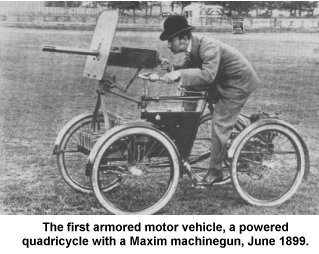Armor in World War II
A short History
Tanks made their first appearance on the battlefield in World War I at the Battle of the Somme, 15 September, 1916. A grand total of 32 British tanks were used. This was very close to 100% of the world's supply of tanks. Catching the imagination of the public and surprising the Germans, tanks gave the British their greatest success in the first two years of the war.Ten days later, 13 tanks were used to assault the village of Thiepval. Of these, nine became stuck in the mud or craters, two more broke down due to mechanical failure and only two reached the village. Yet one of these tanks was able to clear 1,000 meters of trench capturing eight officers and 362 men.
Even these modest gains were sufficient to convince most military leaders of the value of the Armored Fighting Vehicle on the battlefield. Curiously, the Germans who, from their World War II experience are closely associated with the iron behemoths, were at the time largely uninterested. The British continued to employ tanks on the western front, but they deployed them in small groups which limited their effectiveness.
Seven months later, 16 April, 1917, the French launched the first large-scale tank offensive during the Second Battle of the Aisne River. Here 128 French vehicles were able to penetrate three lines of defenses and strike into the rear areas of the German army. Unfortunately, the accompanying infantry couldn't keep up. Acting on orders, the tankers stopped to wait for the infantry advance and quickly became easy prey for German artillery. In time, the tanks were forced to withdraw negating most of the gains made by the world's first armored breakthrough.
 This offensive showed that when employed in large numbers, tanks
could be used to break the stalemate of the trenches. Or at least
that's what it shows us today using twenty-twenty hindsight. Both
the French and the British seemed to have missed that lesson.
Instead, they focused on the forced withdrawal of the farthest
advanced vehicles and concluded that tanks should remain with the
infantry instead of attempting to exploit breakthrough
opportunities and so the stalemate continued.
This offensive showed that when employed in large numbers, tanks
could be used to break the stalemate of the trenches. Or at least
that's what it shows us today using twenty-twenty hindsight. Both
the French and the British seemed to have missed that lesson.
Instead, they focused on the forced withdrawal of the farthest
advanced vehicles and concluded that tanks should remain with the
infantry instead of attempting to exploit breakthrough
opportunities and so the stalemate continued.
For the rest of the war, the British, French and soon the Americans employed their tanks in small packets for localized infantry support. Consequently, tanks never achieved their potential in the First World War. Even so, the Allies recognized the potential of the Armored Fighting Vehicle and in the Treaty of Versailles restricted Germany to the possession of a single tank1 .
Following World War I, military staffs of all nations studied the battles and began to recognize the profound importance of the Armored Fighting Vehicle. Each nation, however, drew slightly different lessons from the fighting on the western front. These differing opinions manifested themselves in tank design, military doctrine and had a major impact on the nature of combat in World War II. In the ensuing pages we will take a look at these differences of opinion and how it affected the progress of the Second World War in Europe.
____________________ Unless otherwise stated, images accompanying this article were
taken from "Design and Development of Fighting Vehicles," R.M. Ogorkiewicz.
1. Article 171 of the Treaty of Versailles states
in part, "Germany is likewise forbidden to manufacture or import
armored vehicles, tanks, or similar machines which may be turned
to military use." Possession of a single tank would not violate
the provisions of this article.
Page Last Updated 05/09/00
This page has been visited times
since April, 30, 1999.